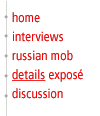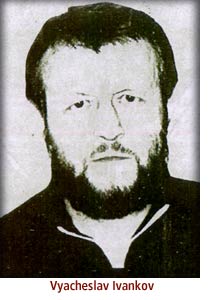
 | 
 Almost fifty years ago, in 1950 and 1951, a Special Committee of the U.S.
Senate held nationally televised hearings on a subject never before given such
a significant public forum: the Mafia and organized crime. The Committee,
chaired by Senator Estes Kefauver of Tennessee, introduced average Americans to
men like Lucky Luciano, Vito Genovese, and Meyer Lansky, and detailed their
business -- gambling, corrupt infiltration of legitimate business, and
violence. The Committee's final report famously concluded: "There is a
Nation-wide crime syndicate known as the Mafia, whose tentacles are found in
many large cities. . . Its leaders are usually found in control of the most
lucrative rackets in their cities. . . There are indications of a centralized
direction and control of these rackets. . . The domination of the Mafia is
based fundamentally on 'muscle' and 'murder.'"
Almost fifty years ago, in 1950 and 1951, a Special Committee of the U.S.
Senate held nationally televised hearings on a subject never before given such
a significant public forum: the Mafia and organized crime. The Committee,
chaired by Senator Estes Kefauver of Tennessee, introduced average Americans to
men like Lucky Luciano, Vito Genovese, and Meyer Lansky, and detailed their
business -- gambling, corrupt infiltration of legitimate business, and
violence. The Committee's final report famously concluded: "There is a
Nation-wide crime syndicate known as the Mafia, whose tentacles are found in
many large cities. . . Its leaders are usually found in control of the most
lucrative rackets in their cities. . . There are indications of a centralized
direction and control of these rackets. . . The domination of the Mafia is
based fundamentally on 'muscle' and 'murder.'"
In the decades since the Kefauver report we have learned more about the Mafia
in America -- some have said that Italian mobsters' popular celebrity in books,
movies, and television has grown while their actual power as a criminal
syndicate has waned. At the same time, we also have frequently heard of the
"changing face" of organized crime in America, with new groups challenging La
Cosa Nostra for criminal dominance of illegal markets: Chinese Triads and
Tongs, Jamaican Posses, Colombian Drug Cartels, Vietnamese Gangs. Beginning in
the late 1980's, a new group was added to the list -- the Russian Mafia --
centered in Brighton Beach, Brooklyn, the largest Soviet/Russian emigre
community in the United States.
The questions that U.S. law enforcement and criminologists began to ask of the
Russian Mafia in the mid-1990's recalled the earlier questions of the Kefauver
Committee with respect to La Cosa Nostra: Is there a Russian mafia in America?
If so, is it centrally organized and directed? How deeply has it penetrated
legal and illegal markets? Answers are not easy to come by, but no response
could be complete without considering the biggest Russian crime figure to be
caught and tried in the United States: Vyacheslav Ivankov or, as he was
nicknamed, Yaponchik ("Little Japanese") -- the same man whose connection to
hockey star Slava Fetisov raised concerns for the NHL.
Was Ivankov sent to America by Russian organized crime leaders to run all North
American operations? This was the view put forward by the FBI and reported
widely by the press, but what was it based on? One reporter, Scott Anderson,
writing in Harper's Magazine in December, 1995, went to Brighton Beach
in search of Ivankov and came away a skeptic. Anderson concluded:
"Ivankov was a mafia godfather because it served everyone's interest that he be
one. It gave the media a frame, a way to personalize stories about a complex
issue. It gave the FBI a symbol to take down, a tool with which to convince
the Russian emigré community that justice would prevail. . . And not
least of all, it gave Ivankov the necessary status and cachet to be called upon
as muscle [in extortion and protection rackets] in the first place." ("Looking
For Mr. Yaponchik," p. 51)
Who was Ivankov? In this excerpt from Russian Mafia in America
(Northeastern University Press, 1998), James O. Finckenauer, a Professor of
Criminal Justice at Rutgers University, and an expert on Russian organized
crime, reviews all the evidence on Ivankov and offers this authoritative
assessment.

home |
interviews |
russian mob in north america |
details expose |
ivankov: taking a closer look |
video excerpt |
join the discussion
glossary |
links |
who's who |
tapes & transcripts |
synopsis |
press
FRONTLINE |
pbs online |
wgbh
New Content Copyright © 1999 PBS Online and WGBH/FRONTLINE
 | |